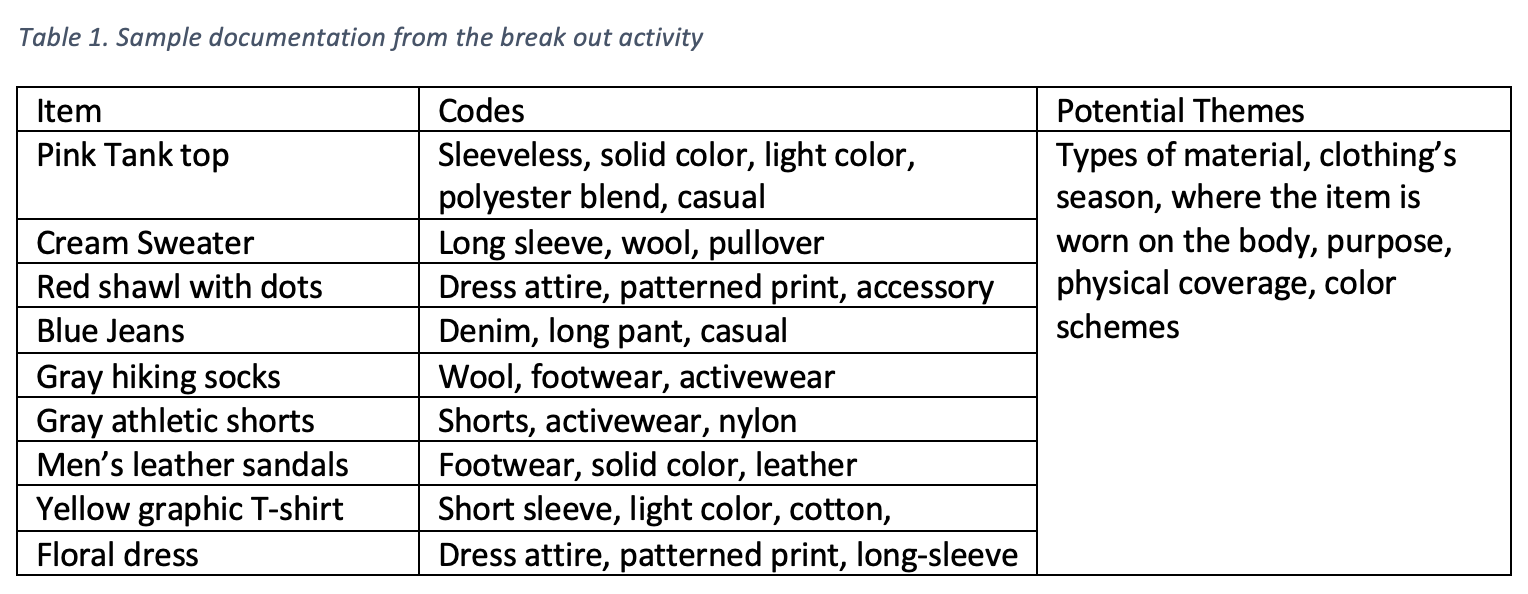
I’m JoAnna Hillman, Director of the Center for Program Evaluation and Quality Improvement with Emory Centers for Public Health Training and Technical Assistance at Emory University.
I love helping people learn evaluation in simple ways that leave them feeling empowered to try it themselves. A topic that I receive frequent requests for training on is qualitative evaluation. I often hear of people being intimidated by qualitative analysis, so I created this Collective Closet activity to teach inductive qualitative coding and analysis through an everyday life example. The objective is to raise confidence levels in understanding how to conduct a qualitative analysis, not to make them experts.
Session preparation:
Ask each participant to bring 1-2 items from their wardrobe that they are comfortable sharing to the session (give them free rein to bring what they wish). Alternatively, you could do this activity with pantry items.
Materials:
- If not in-person, Zoom or another virtual platform (with breakout group capability)
- One lead instructor and one facilitator for every 4-5 learners
- Blank word document to record items, codes, and themes
- PowerPoint with didactic content
Lesson plan:
- Introduce a basic qualitative approach to evaluation, up to the stage of having raw qualitative data. Share how a qualitative approach is valuable in situations where an evaluation needs to be more exploratory in nature.
- Explain the Collective Closet activity as an exercise to understand the types of items that learners have in their closets. This will be an exercise in exploring what themes emerge from the items shared.
- The large group will split into breakout groups, with an assigned facilitator who is familiar with the activity. The facilitator will share their screen with a blank Word document and learners will take turns sharing their items. The facilitator will take descriptive notes on each item and ask the group to suggest possible codes for the item. After the items are coded, the facilitator will lead the group in exploring themes within the coded data. Lastly, the facilitator will ask for a volunteer to report out on the group’s findings to the large group.
- The breakout groups will work on the activity for 30-45 minutes and finish with a completed Word document (see example in Table 1).
- Reconvene the large group and ask groups to share their Word document. Ask learners what aspects were the most challenging and easiest. As groups share, the instructor should point out different ways items were categorized. In closing, ask how learners’ experiences would have differed if they began with an evaluation question or framework to guide their analysis.
- Finish with a didactic presentation explaining the steps of qualitative analysis. I use one that I’ve based on “Analyzing Qualitative Data” by Ellen Taylor-Powell and Marcus Renner. Explain that they conducted qualitative analysis using emergent categories (inductive), but that you can use a framework with preset categories instead (deductive).

Hot tips:
- If learners are shy to share potential codes, encourage them to think in hashtags. Ask “If you were to hashtag this item, what hashtags would you use?”
- Let them struggle a bit with codes versus themes. Allow all codes that learners mention to start. After a few minutes, someone will inevitably suggest that a code seems more overarching in nature, and the conversation will gravitate to which descriptors are codes versus themes. Next, refine the codes and themes. You’ll start to see the lightbulbs go off as they react to these situations.
- Remember, learning complex evaluation methods does not need to be complex!
The American Evaluation Association is hosting Teaching of Evaluation TIG week. All posts this week are contributed by members of the ToE Topical Interest Group. Do you have questions, concerns, kudos, or content to extend this AEA365 contribution? Please add them in the comments section for this post on the AEA365 webpage so that we may enrich our community of practice. Would you like to submit an AEA365 Tip? Please send a note of interest to AEA365@eval.org. AEA365 is sponsored by the American Evaluation Association and provides a Tip-a-Day by and for evaluators. The views and opinions expressed on the AEA365 blog are solely those of the original authors and other contributors. These views and opinions do not necessarily represent those of the American Evaluation Association, and/or any/all contributors to this site.
